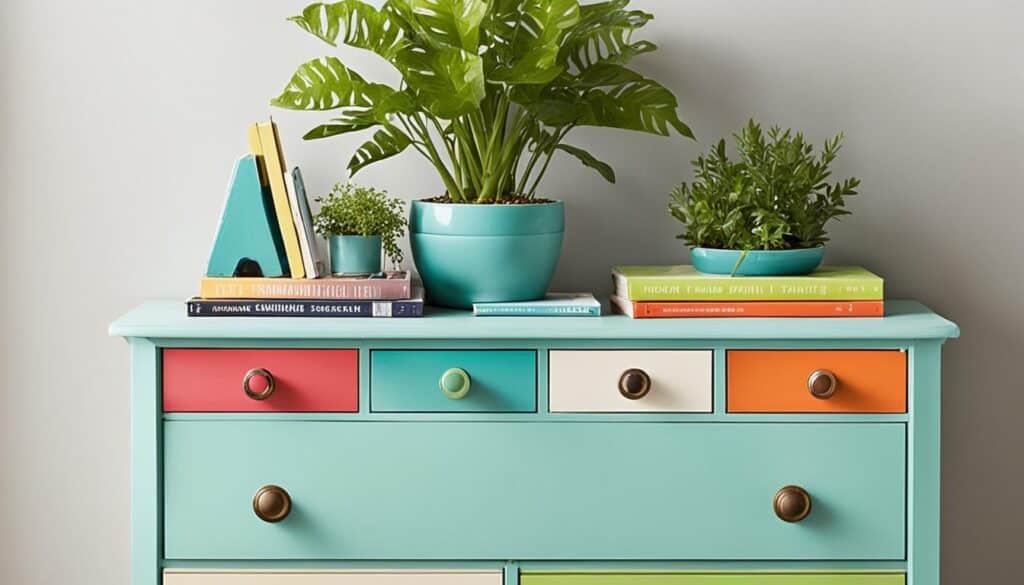Are you tired of the same old furniture in your home? Do you want to add a touch of creativity and sustainability to your space? Look no further than the world of upcycling and repurposing. These innovative practices breathe new life into old furniture by transforming it into something fresh, unique, and environmentally friendly.
When we think of upcycling and repurposing, we envision turning discarded items into functional pieces that add character and personality to our homes. It’s a way to break free from the monotony of mass-produced furniture and create something truly special.
But why does upcycling and repurposing matter? Not only does it reduce waste and promote sustainability, but it also allows us to tap into our creativity and turn ordinary objects into extraordinary works of art.
In this article, we will explore the world of upcycling and repurposing old furniture, discussing its benefits, providing tips, and showcasing some inspiring examples. Join me as we dive into the exciting and sustainable world of giving old items new life.
Key Takeaways:
- Upcycling and repurposing breathe new life into old furniture.
- These practices promote sustainability and reduce waste.
- Upcycling and repurposing allow us to unleash our creativity.
- By upcycling and repurposing, we can create unique pieces of furniture.
- The possibilities for transforming old furniture are endless.
Why Upcycling and Repurposing Matter
Upcycling and repurposing matter because they have a significant impact on sustainability and waste reduction. Instead of buying new furniture or throwing away old items, upcycling and repurposing allow us to reuse existing materials and reduce the demand for new resources. By extending the lifespan of furniture, we save energy and reduce greenhouse gas emissions associated with the production and transportation of new products. Additionally, upcycling and repurposing promote creativity and innovation, as they require us to think outside the box and find new ways to use old items.
To illustrate the environmental impact of upcycling and repurposing, consider the following statistics:
In the United States, furniture accounts for approximately 9.8 million tons of waste disposed of each year, according to a study conducted by the Environmental Protection Agency (EPA).
By diverting furniture from landfills through upcycling and repurposing, we can make a substantial dent in these staggering waste figures. Not only does this contribute to a more sustainable society, but it also helps conserve valuable resources and reduces the negative environmental impact associated with furniture production and disposal.
Furthermore, upcycling and repurposing foster a culture of sustainability and inspire others to adopt eco-friendly practices. By promoting the idea of giving old items new life, we encourage individuals to think critically about their consumption habits and the potential for waste reduction. This shift in mindset can lead to long-term behavioral changes that have far-reaching benefits for the planet.
The Benefits of Upcycling and Repurposing
Let’s take a closer look at the benefits of upcycling and repurposing furniture:
- Waste Reduction: By upcycling and repurposing old furniture, we divert items from landfills, reducing the amount of waste that ends up polluting the environment.
- Resource Conservation: Upcycling and repurposing reduce the demand for new resources, helping to conserve materials such as wood, metal, and fabric.
- Energy Savings: Extending the lifespan of furniture means that we save energy that would have been consumed during the production, transportation, and disposal of new items.
- Carbon Footprint Reduction: By reducing the need for new furniture production, upcycling and repurposing help lower greenhouse gas emissions associated with manufacturing processes.
- Creativity and Innovation: Upcycling and repurposing challenge us to think creatively and find new uses for old items, fostering a culture of innovation and resourcefulness.
Real-Life Examples of Upcycling and Repurposing
To further illustrate the impact and potential of upcycling and repurposing, here are a few real-life examples:
| Before | After |
|---|---|
 | |
These examples demonstrate how ordinary furniture pieces can undergo incredible transformations with a little creativity and skill. By upcycling and repurposing, individuals have transformed old chairs into trendy statement pieces, given new life to worn-out dressers, and turned outdated suitcases into stylish storage solutions.
In conclusion, upcycling and repurposing matter because they contribute to sustainability and waste reduction. By reusing and transforming old furniture, we can make a positive impact on the environment while showcasing our creativity. Upcycling and repurposing empower us to take control of our consumption habits and create a more sustainable future.
Tips for Upcycling and Repurposing Old Furniture
If you’re interested in upcycling and repurposing old furniture, here are some tips to get you started:
Assess the condition of the furniture: Before you begin your upcycling project, inspect the furniture to determine if any repairs or cleaning are needed. This will ensure a solid foundation for your transformation.
Consider your desired use: Think about how you want to use the furniture in your space. Do you need a new bookshelf, a unique coffee table, or a stylish statement piece? Having a clear purpose in mind will guide your creative process.
Get creative with paint, fabric, or other materials: One of the most exciting aspects of upcycling is the opportunity to transform the look of a piece. Experiment with different paint colors, upholstery fabrics, or even decoupage techniques to give the furniture a fresh and personalized look.
Seek inspiration for DIY projects: Looking for inspiration is an essential part of the upcycling journey. Explore online platforms, such as Pinterest or Instagram, for innovative DIY projects and creative ideas. You can also browse through magazines or visit local thrift stores to find unique design concepts.
Consider functionality and practicality: While creativity is important, it’s essential to balance it with functionality. Ensure that the repurposed furniture serves a purpose in your space and aligns with your everyday needs and activities.
By following these tips, you’ll be well-equipped to embark on your upcycling and repurposing adventure, transforming old furniture into unique pieces that reflect your personal style and contribute to a more sustainable lifestyle.
Examples of Upcycling and Repurposing Old Furniture
Upcycling and repurposing old furniture offer endless possibilities for transforming worn-out pieces into unique and functional items. Through creative thinking and innovative design, old furniture can undergo stunning transformations that breathe new life into them. From converting an old dresser into a stylish kitchen island to repurposing a wooden pallet into a rustic coffee table, these examples showcase the potential for turning outdated pieces into eye-catching focal points.
Before and After: A Tale of Transformation
One popular trend in upcycling and repurposing is showcasing the incredible before and after results. Many people have harnessed their creativity and shared their transformation stories online, inspiring others to embark on their own furniture makeover journeys. These before and after photos depict the incredible possibilities that lie within each old item, waiting to be rediscovered.
I stumbled upon a dilapidated wooden desk at a flea market, barely recognizable amidst the clutter. Determined to give it new life, I rolled up my sleeves and set to work. After a fresh coat of paint, some sanding, and the addition of new knobs, the desk was transformed into a charming vanity table. From a neglected piece to a statement of elegance, the metamorphosis was truly remarkable.
Such transformations not only showcase the potential for breathing new life into old furniture but also demonstrate the unique and personal touch that each creator infuses into their pieces. By upcycling and repurposing, individuals can bring their vision to life and create one-of-a-kind furniture that reflects their style and values.
Inspiring Unique Pieces
The beauty of upcycling and repurposing lies in the ability to create distinct and unique pieces that cannot be found in any store. By thinking outside the box and pushing the boundaries of traditional furniture design, individuals can craft remarkable and unexpected items.
For example, an old sewing table can be transformed into a functional and stylish bar cart, complete with storage for bottles and glassware. The unique blend of vintage charm and modern functionality makes it an eye-catching conversation starter in any home. Similarly, repurposing an antique ladder into a bookshelf adds a touch of rustic character while showcasing a passion for literature.
From quirky plant stands made from upcycled chairs to repurposed suitcases as bedside tables, the possibilities for creating extraordinary pieces are limited only by one’s imagination. Each unique item contributes to a more sustainable lifestyle by saving resources and reducing waste.
By exploring these examples of upcycling and repurposing old furniture, it becomes evident that transforming old items can result in remarkable outcomes. From breath-taking before and after photos to the creation of unique and sustainable pieces, the art of upcycling and repurposing allows us to reimagine the potential of old furniture.
Conclusion
Upcycling and repurposing old furniture offer a plethora of benefits that go beyond just giving new life to old items. With these practices, we can make a significant impact on reducing waste, decreasing our carbon footprint, and expressing our creativity. By transforming old furniture into unique and meaningful pieces, we not only contribute to a more sustainable future but also create a personalized space that reflects our own style.
One of the key advantages of upcycling and repurposing is the reduction of waste. By utilizing existing materials, we can divert furniture from ending up in landfills, thereby minimizing our environmental impact. This helps to conserve resources and reduce the energy consumption associated with the production and transportation of new furniture.
In addition to the environmental benefits, upcycling and repurposing allow us to unleash our creativity and explore endless possibilities. Whether it’s refurbishing an old dresser with a fresh coat of paint or turning reclaimed wood into a unique shelving unit, the process of transforming old furniture into something extraordinary is an opportunity to showcase our artistic flair and create truly personalized pieces.
Whether you’re an experienced DIY enthusiast or just starting out, upcycling and repurposing old furniture offer an accessible and rewarding way to make a difference. By embracing these practices, we can contribute to a more sustainable lifestyle, add charm and character to our spaces, and make a positive impact on the world. So, join the revival journey and let your imagination run wild!
FAQ
What is upcycling?
Upcycling is the process of transforming old or discarded items into something new and of higher value.
How is upcycling different from recycling?
While recycling involves breaking down materials to create new products, upcycling focuses on repurposing and giving new life to items without breaking them down.
What are the benefits of upcycling and repurposing old furniture?
Upcycling and repurposing old furniture contribute to sustainability by reducing waste, decreasing carbon footprint, and promoting creativity.
How can I get started with upcycling and repurposing old furniture?
To begin, assess the condition of the furniture and determine if any repairs or cleaning are needed. Consider your desired use for the furniture and get creative with paint, fabric, or other materials to transform it.
Where can I find inspiration for DIY upcycling projects?
You can find inspiration online through websites, blogs, and social media platforms dedicated to upcycling and repurposing. Magazines and books on the subject are also great sources of creative ideas.
What are some examples of upcycling and repurposing old furniture?
Examples include converting an old dresser into a kitchen island or repurposing a wooden pallet into a coffee table. The possibilities are endless and can be tailored to suit your personal style and needs.
How can upcycling and repurposing old furniture contribute to a more sustainable lifestyle?
By giving old furniture new life, you reduce the demand for new resources, save energy, and reduce greenhouse gas emissions associated with the production and transportation of new products.


